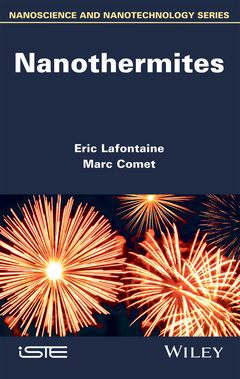Nanothermites
Auteurs : Lafontaine Eric, Comet Marc

The recent introduction of the ?nano? dimension to pyrotechnics has made it possible to develop a new family of highly reactive substances: nanothermites. These have a chemical composition that is comparable to that of thermites at submillimeter or micrometric granulometry, but with a morphology having a much increased degree of homogeneity. This book discusses the methods of preparation of these energetic nanomaterials, their specific properties, and the different safety aspects inherent in their manipulation.
Introduction ix
Chapter 1. Elaboration of Nanoparticles 1
1.1. Solid-phase elaboration 2
1.1.1. Mechanical milling 2
1.2. Liquid-phase elaboration 19
1.2.1. Sonochemistry 19
1.2.2. Microemulsion synthesis 23
1.2.3. Solvothermal syntheses 28
1.2.4. Sol-gel syntheses 39
1.3. Gas-phase elaboration 43
1.3.1. Condensation in inert gas 43
1.3.2. Explosion of metal wires 46
1.3.3. Thermal plasma synthesis 48
1.3.4. Laser ablation 60
1.3.5. Pyrotechnic synthesis 73
Chapter 2. Methods for Preparing Nanothermites 87
2.1. Introduction 87
2.2. Physical mixing 89
2.2.1. Mixing in hexane 89
2.2.2. Mixing in isopropanol 92
2.2.3. Mixing in water 95
2.2.4. Mixing in other solvents 96
2.2.5. Dry mixing 97
2.2.6. Aerosol synthesis of the “building blocks” for physical mixing 98
2.3. Coating 100
2.3.1. Coating oxide with fuel 101
2.3.2. Coating fuel with oxide 102
2.3.3. Coating of fuel with a metal layer 104
2.4. Sol-gel method 104
2.4.1. Formation of oxide around the metal particles 105
2.4.2. Preparation of oxides subsequently mixed with metal 108
2.5. Impregnating porous solids 111
2.6. Assembly 114
2.6.1. Chemical methods 114
2.6.2. Biological methods 117
2.6.3. Electrical methods 118
2.7. Structuring at the surface of substrates 121
2.8. Conclusions and perspectives 125
Chapter 3. The Experimental Study of Nanothermites 127
3.1. Introduction 127
3.2. Study and properties of main fuels 128
3.2.1. Nanometric aluminum 129
3.2.2. Other fuels of interest 157
3.3. Oxidizers of interest for nanothermites 166
3.3.1. Metal or metalloid oxides 167
3.3.2. Oxidizing salts 189
3.4. Methods for the characterization of nanothermites 195
3.4.1. Reactive characterization 196
3.4.2. Morphological characterizations 219
3.5. Conclusion: performance of nanothermites and their enhancement 225
Chapter 4. Nanothermites and Safety 229
4.1. Introduction 229
4.2. Pyrotechnic safety 229
4.2.1. Definition and measurement of sensitivity 230
4.2.2. Techniques used for the desensitization of nanothermites 232
4.2.3. Pyrotechnic risk assessment 236
4.2.4. Regulatory aspects 239
4.3. Neutralization of nanothermites 239
4.4. Toxicological risk 243
4.4.1. Toxicity of the constituents and reaction products of nanothermites 244
4.4.2. Analyses of specific risks and good practices 250
4.5. Conclusions and perspectives 257
Conclusion 259
Bibliography 263
Index 323
Eric Lafontaine is in charge of the scientific field at the Direction générale de l'armement (French Government Defense procurement and technology agency). He specializes in the property structure relationships of materials.
Marc Comet is a researcher at Laboratoire NS3E (ISL - CNRS - University of Strasbourg) in France. His achievements include many publications, patents and international distinctions in the field of nanothermites and energetic nanomaterials.
Date de parution : 07-2016
Ouvrage de 344 p.
16.5x24.1 cm
Thème de Nanothermites :
Mots-clés :
introduction; nanoparticles; elaboration; mechanical; condensation; inert gas; metal; explosion; plasma; methods; nanothermites; hexane; isopropanol; solvents; physical; synthesis; building blocks; aerosol; oxide; fuel; layer



